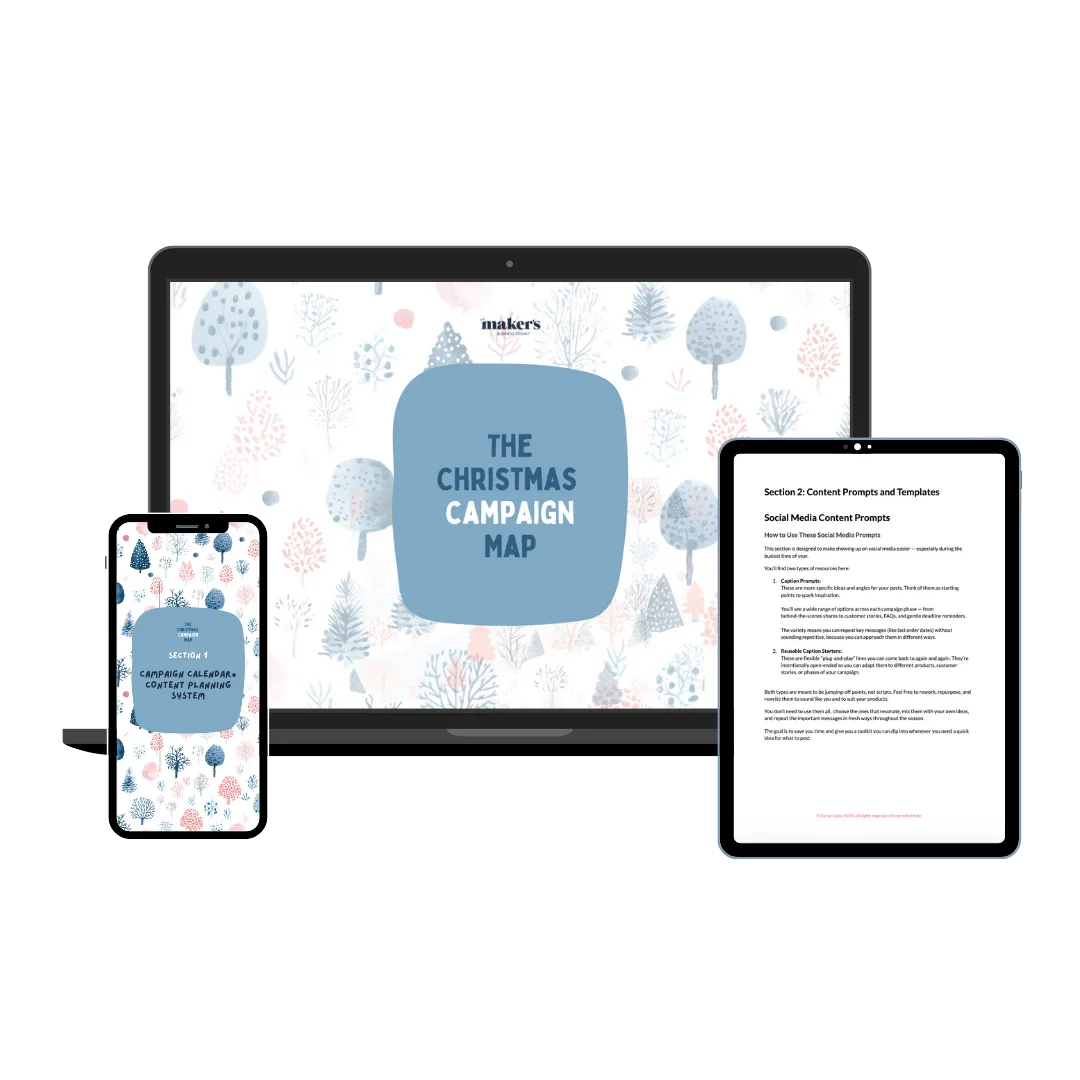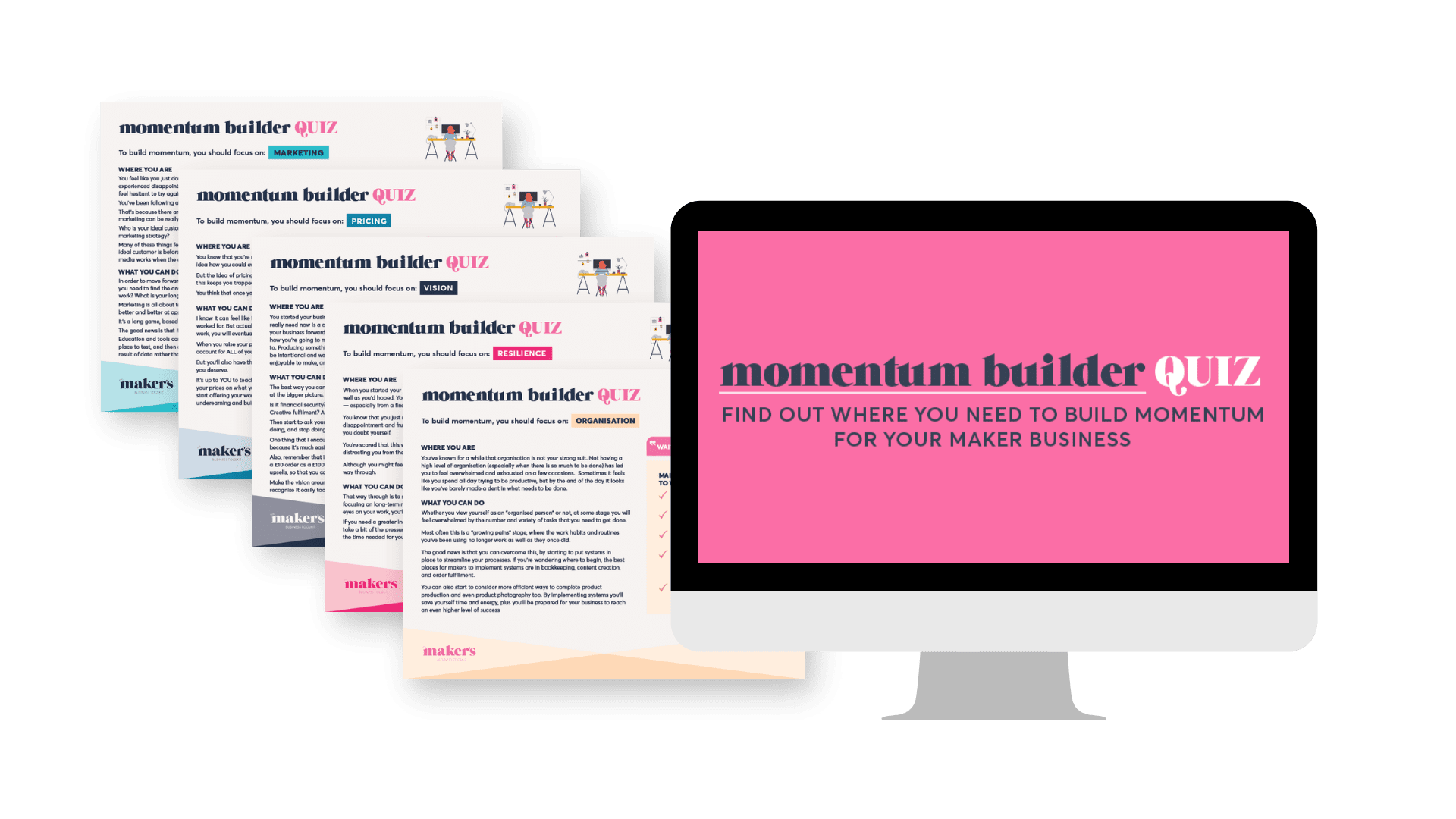Most goal setting advice starts with a version of this question: “What do you want to achieve?”
But if you’re a maker whose working hours change every week – because of family, health, day jobs, holidays, or just the general unpredictability of life – that question can feel like it just doesn’t apply to you.
It’s for people with a team of helpers, or no children, or a predictable routine.
So what do you do if your life and business hours are inconsistent, unpredictable or just unconventional and you still want to move forward?
How do you grow your creative business in a way that feels intentional, rather than chaotic?
Here’s how to set goals that actually work for the life you have — even when your working time is anything but consistent.
1. Start With What You Know You’ve Got
Most people start goal setting with what they want. But that only works if you have consistent time to allocate.
Instead, start by mapping out what you have — time-wise.
- Look at the month ahead and estimate your available working hours.
- Be honest. Don’t assume best-case scenarios.
- Account for energy, too. A day of caregiving or a bad pain flare will reduce what you can realistically do.
And if your life is still too unpredictable for that, try a best guess.
And remember, this isn’t a competition for the best guess. We’re just trying to start monitoring the situation.
It does not matter if it’s nowhere near reality – we’re looking for any tiny bit of extra information that helps us understand what you can do in a reasonably stable and distraction-free day/week/month, and what you can do in a day/week/month that’s not so good.
Even with inconsistency it’s worth trying to look for the patterns, because they will make it easier to choose a goal that actually fits.
2. Choose a Direction, Not a Destination
Instead of asking “What do I want to achieve this month?”, ask:
- What direction do I want to move in?
- What part of a bigger project could I reasonably progress in the time I have?
If your ultimate goal is “launch a website,” your monthly goal might just be:
- Finish product descriptions
- Take your first 10 photos
- Choose a platform and sign up
Each of these is a stage and when life is inconsistent it’s important to be mindful of what you ultimately want, but to think in terms of those stages.
Because stages — not end goals — are where real progress is made, especially if your work comes in short bursts.
3. Break Your Goal Into Stop-and-Start Friendly Tasks
Big goals get derailed when it’s hard to remember what you were doing, and it’s really hard to remember what you were doing after some time off (especially if life has been chaotic during that time)
Make your goals easy to pause and resume by breaking them into:
- Stages (e.g. “prep products” → “photograph” → “upload”)
- Jobs within each stage (e.g. “Write descriptions for 5 products”)
- Time-blocked chunks (e.g. “Edit photos for 25-minutes”)
Each level gives you a smaller, clearer re-entry point if your time gets interrupted.
Bonus tip: keep a sticky note or scratch pad with “next up” tasks written down. That way, when you sit down to work, you’re not starting from zero.
And if your time off is planned, for example a holiday or sabbatical, then take some time before you go to make some notes that will help you remember where you were and what you were doing. Your future self will thank you!
4. Plan Your Time in Blocks — Not Days or Weeks
If your schedule varies, weekly planning will often let you down. That’s why I recommend you fill out your tasks in the Maker’s Yearbook every day, rather than filling a week out all at once.
Instead of weekly planning, try this:
- Choose a time block that suits your energy (25–50 minutes is a good place to start, but even 5-10 minutes work on something can make a difference)
- Use those blocks as your unit of planning (“This task will take 2 blocks,” etc.)
- Log how many blocks you complete each week — and what you finish in that time
This helps you learn how long things really take — and helps you adjust your expectations over time.
Don’t forget to make notes about what happened in the week, so you can understand the outside factors influencing your work in that timeframe.
5. Map Long-Term Goals Like a Series of Checkpoints
Long-term goals such as new product ranges, websites or email sequences, can absolutely be tackled with a stop-start workflow. The key is setting up the structure.
Think of your big goal like a path made up of small, named checkpoints.
Let’s say your big goal is “Start selling wholesale.”
Your checkpoint map might look like this:
- Decide what products to include
- Create line sheet template
- Photograph 3 core products
- Write product copy
- Draft 3 outreach emails
- Send to first 5 shops
Each of these is something you could potentially work on in a 1–2 week burst, or in 30-minute increments. And because each checkpoint stands alone, you can pause without losing the thread of what you were doing.
This approach gives you a sense of continuity without needing to work every day or every week.
6. Track Progress, Not Just Plans
In a stop-start business, it’s easy to get a little disheartened and lose momentum just because you can’t see how far you’ve come.
So don’t just write down what you want to do. Keep a visual record of what you’ve done.
- Cross off completed stages
- Keep a “done list” at the bottom of your planner page
- Use sticky notes or index cards you can move to a “complete” pile
Seeing your own progress shows you just how far you’ve come and it helps to keep your motivation going when life keeps pulling you in and out of your business.
7. Review Often — and Adjust Without Shame
At the end of each month (or season), ask:
- Did I complete my goal or at least move in the right direction?
- If not, what got in the way — and what part did work?
- What might I need to adjust next time?
Your monthly goals aren’t tests to pass and they shouldn’t make you feel defeated, because it doesn’t actually matter if you hit your goal or not.
In fact, you’re not supposed to always hit them.
What matters is whether you got closer to what you really want.
Your goals are a tool to help you do that. They’re just experiments and there’s no moral victory in hitting them and no shame in missing them.
They’re only there to help you learn how to make your working time more mindful and more aligned with the things you want out of life.
A Final Word
You don’t need a consistent schedule to make consistent progress.
You just need:
- An overall idea of what you want from your life and your business
- A goal that matches your capacity
- A plan that breaks the work into manageable pieces
- A system to keep track of where you left off
- And a way to reset quickly when life happens
It’s not about perfect execution — it’s about building the muscle of re-entry.
The skill that matters most isn’t how much you can do in one perfect week. It’s how many times you can come back to your goal, pick it up again, and keep moving forward — one small, mindful step at a time.
Need Help Putting This Into Practice?
This is exactly the kind of planning rhythm that The Maker’s Yearbook was designed to support.
I designed it as a system that could still work with imperfect schedules and lifestyles, as well as imperfect people (of whom I am one!)
It gives you space to set realistic monthly goals, choose your three most important tasks each day, and keep track of your progress — without needing a perfect routine or a bright and early start.
It’s a flexible structure for those always running to catch up, always losing track, always feeling like there isn’t enough time.
It flexes up and down with the unpredictability of life and your own energy and motivation, because it was designed with precisely that in mind
You can learn more about the yearbook at https://makersbusinesstoolkit.com/makers-yearbook









